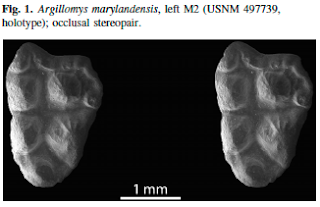New multituberculate mammal from the Early Cretaceous of eastern North America
Authors:
1. Richard L. Cifelli (a)
2. Cynthia L. Gordon (b)
3. Thomas R. Lipka (a)
Affiliations:
a. Sam Noble Museum, 2401 Chautauqua Ave. Norman, OK 73072, USA.
b. Department of Biology, University of Oklahoma, Norman, OK 73019, USA.
Abstract:
Multituberculates, though among the most commonly encountered mammalian fossils of the Mesozoic, are poorly known from the North American Early Cretaceous, with only one taxon named to date. Herein we describe Argillomys marylandensis, gen. et sp. nov., from the Early Cretaceous of Maryland, based on an isolated M2. Argillomys represents the second mammal known from the Arundel Clay facies of the Patuxent Formation (Lower Cretaceous: Aptian). Though distinctive in its combination of characters (e.g., enamel ornamentation consisting of ribs and grooves only, cusp formula 2:4, presence of distinct cusp on anterobuccal ridge, enlargement of second cusp on buccal row, central position of ultimate cusp in lingual row, great relative length), the broader affinities of Argillomys cannot be established because of non-representation of the antemolar dentition. Based on lack of apomorphies commonly seen among Cimolodonta (e.g., three or more cusps present in buccal row, fusion of cusps in lingual row, cusps strongly pyramidal and separated by narrow grooves), we provisionally regard Argillomys as a multituberculate of “plagiaulacidan” grade. Intriguingly, it is comparable in certain respects to some unnamed Paulchoffatiidae, a family otherwise known from the Late Jurassic – Early Cretaceous of the Iberian Peninsula.
Friday, April 19, 2013
New Maryland Multituberculate Mammal From the Aptian Cretaceous
Labels:
aptian,
cretaceous,
fossils,
mammals,
mesozoic,
multituberculates,
North america,
paleontology
Subscribe to:
Post Comments (Atom)

No comments:
Post a Comment